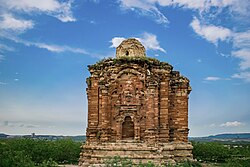| Malot Fort | |
|---|---|
 A view of Malot Fort | |
 | |
| General information | |
| Location | Chakwal District, Pakistan |
| Coordinates | 32°41′0″N 72°48′0″E / 32.68333°N 72.80000°E |
| Completed | 10th Century |
Malot Fort (Urdu: ملوٹ قلعہ) is a temple-fortress located in Chakwal District in the Punjab Province of Pakistan.[1][2] It is part of the Salt Range in Kalar Kahar.[3][4]
History
[edit]
Malot Fort was built in the 10th century AD and has the synthesis of Kashmiri and Greek architecture.[5] Constructed following the decline and eventual disappearance of Greek Taxila, Malot Fort was developed by the stonemasons of the Potohar plateau who preserved the Greek architectural techniques across multiple generations.[6] Rudyard Kipling described it in his novel, Kim as "...by workmen whose hands were feeling, and not unskilfully, for the mysteriously transmitted Grecian touch."[6]
Over the course of a millennium, the hill on which Malot resides has experienced geological alterations, resulting in the formation of narrow fissures.[5]
Architecture
[edit]Malot Fort built of local red sand stones of Salt Range mountains, is located on the road leading to Malot village near Choi village.
References
[edit]- ^ "Important Places in Chakwal".
- ^ "سالٹ رینج میں واقع قدیم ملوٹ قلعہ". jang.com.pk.
- ^ "سالٹ رینج میں واقع ملوٹ قلعہ اورمندروں کی بحالی - ایکسپریس اردو".
- ^ "Roznama Dunya: اسپیشل فیچرز :- قلعہ ملوٹ توڑ پھوڑکا شکار". Roznama Dunya: اسپیشل فیچرز :-.
- ^ a b "Preserving Malot fort". DAWN.COM. April 18, 2010.
- ^ a b "Footloose, NOS,". The News International.

Well, that’s interesting to know that Psilotum nudum are known as whisk ferns. Psilotum nudum is the commoner species of the two. While the P. flaccidum is a rare species and is found in the tropical islands. Both the species are usually epiphytic in habit and grow upon tree ferns. These species may also be terrestrial and grow in humus or in the crevices of the rocks.
View the detailed Guide of Psilotum nudum: Detailed Study Of Psilotum Nudum (Whisk Fern), Classification, Anatomy, Reproduction